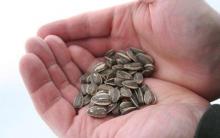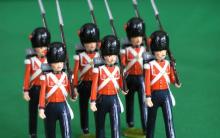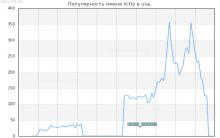One of the most popular Polish artists of the 20th century, Zdzislaw Beksinski, almost never gave titles to his works. This is also why his post-apocalyptic paintings are perceived as a kind of holistic world. A world of horror, despair or whatever else you see in these paintings. The dark corridors of life attract the audience's attention, which is why Beksinski was favored by popularity throughout his entire creative life, mainly in Western Europe, Japan and the USA. However, this did not save him from death at the hands of crazy teenagers.
 Beksinski tried himself in many genres: sculpture, photography, graphic art, and turned to painting in the 1960s. The first paintings were painted in the spirit of abstractionism, later surrealistic motifs began to dominate. The author himself believed that he must achieve such a level of skill that the viewer would be convinced that he was photographing dreams. This explains the maximum detail, the saturation of the picture with semantic elements. By the way, the Pole did not have any artistic education.
Beksinski tried himself in many genres: sculpture, photography, graphic art, and turned to painting in the 1960s. The first paintings were painted in the spirit of abstractionism, later surrealistic motifs began to dominate. The author himself believed that he must achieve such a level of skill that the viewer would be convinced that he was photographing dreams. This explains the maximum detail, the saturation of the picture with semantic elements. By the way, the Pole did not have any artistic education.



 The most famous period in his work, the so-called “fantastic” period, continued until the mid-1980s. Phantasmagoric works of this time were dominated by infernal landscapes, nightmarish figures and sinister supernatural architecture. At the same time, the artist argued that most of his works are funny and should not cause internal rejection.
The most famous period in his work, the so-called “fantastic” period, continued until the mid-1980s. Phantasmagoric works of this time were dominated by infernal landscapes, nightmarish figures and sinister supernatural architecture. At the same time, the artist argued that most of his works are funny and should not cause internal rejection.



 Beksinsky painted all of his canvases exclusively to the sounds of classical music (since he could not stand silence) on canvases he prepared with his own hands. In the 90s, he became acquainted with digital technologies and focused his attention on this area.
Beksinsky painted all of his canvases exclusively to the sounds of classical music (since he could not stand silence) on canvases he prepared with his own hands. In the 90s, he became acquainted with digital technologies and focused his attention on this area.


 Beksinski lived with his wife Zofia and son Tomasz in Warsaw. In the last years of the 20th century, a series of misfortunes overtook him. His wife died of cancer, and a year later Tomas, an acclaimed translator, popular music journalist and gothic rock fan, committed suicide. He was a big fan of The Legendary Pink Dots, and after he committed suicide, all the covers of the Polish editions of the band's albums were digitally designed by Beksiński in memory of Tomasz.
Beksinski lived with his wife Zofia and son Tomasz in Warsaw. In the last years of the 20th century, a series of misfortunes overtook him. His wife died of cancer, and a year later Tomas, an acclaimed translator, popular music journalist and gothic rock fan, committed suicide. He was a big fan of The Legendary Pink Dots, and after he committed suicide, all the covers of the Polish editions of the band's albums were digitally designed by Beksiński in memory of Tomasz.


 On February 22, 2005, Beksinski, at the age of 75, was found dead at the door of his own apartment. There were 17 stab wounds on his body. This atrocity was committed by the 19-year-old son of the artist’s housekeeper and his friend, after Zdzislaw refused to lend them money.
On February 22, 2005, Beksinski, at the age of 75, was found dead at the door of his own apartment. There were 17 stab wounds on his body. This atrocity was committed by the 19-year-old son of the artist’s housekeeper and his friend, after Zdzislaw refused to lend them money.
In Polish painting there are many paintings on historical themes, incl. about Russia and Russians. Below is a selection of the most interesting of them. These pictures are worth seeing, friends. They quite clearly reveal the national mentality and attitude of Poles to their past. And to our beloved eastern neighbor, in particular.
Artist in Polish - artysta malarz. Artist-painter, in short. However, the Poles had many talented craftsmen, far from being painters. For example, Jan Matejko and his “romantic nationalism” of the 19th century, battle painter Wojciech Kossak and others. Some paintings are anti-Russian in meaning. But let’s not forget that for the last 300 years, in almost all wars, Russians and Poles were on opposite sides of the barricades.
Jan Matejko. "Stanchik." 1862
1514, another war between Poland and Muscovy. The Russians recaptured Smolensk, and, inspired by their first success, invaded Belarus. But there they were defeated in the battle of Orsha. There is a victory ball in the palace of the Polish king. True, Smolensk as a result of the war remains in the hands of Muscovy. Everyone is dancing (in the background), and the court jester named Stanczyk sits and thinks about the future of Poland. They gave away Smolensk, so we’ll merge everything soon.

An interesting detail: the ball is a European entertainment. The year is 1514, and they are having a ball. In Russia, the first balls at court will take place in 200 years, under Peter.
Jan Matejko. "Stefan Batory near Pskov." 1872
The jester Stanczyk was right. The Muscovites started from Smolensk, then they wanted more. The picture shows the Livonian War, which Ivan the Terrible started to seize the Baltic states. Siege of Pskov by the army of the Polish king Stefan Batory. After several months of siege, Ivan the Terrible's ambassadors sued for peace: in the picture they are crawling on their knees in front of Stefan. There are questions about the plot (in fact, there was no such meeting between Batory and the ambassadors near Pskov), but peace was soon concluded, yes. And really extremely unsuccessful for Russia, like the Livonian War itself.

Interesting detail. To the left of Stefan is a man in red, this is Chancellor Jan Zamoyski. Stefan Batory's classmate University of Padua in Italy. In Russia, the first royal person who will go to study in the West will be Peter (to become a carpenter, to Holland). By the way, even before Stefan Batory, Nicolaus Copernicus, the first world-famous Polish scientist, went to Padua to study. The Russian analogue of Copernicus (Lomonosov) will appear in 250 years.
Tsar False Dmitry I, portrait by an unknown artist. Beginning 17th century
This painting is also known as “Portrait from the Vishnevetsky Castle” (the castle of the family of Marina Mnishek, the wife of False Dmitry). During the Time of Troubles, the Poles managed to put their impostor tsar in the Kremlin. In the painting, Grigory Otrepiev, aka False Dmiry I, is depicted as the Russian Tsar (written in Latin as Demetrius IMPERATOR), on the table there is a crown and a knight’s helmet.

False Dmitry I and his Polish wife, 1605-1606. But guess what: the Polish gentry already learned Latin, built castles and considered themselves part of the European knighthood. Russian nobles will put on European dress, begin to learn languages and claim that they are also Europe - in 5-7 generations.
False Dmitry, however, did not sit on the throne for long. He was overthrown as a result of a popular riot in Moscow. It is interesting to compare the pompous Polish portrait of the impostor with the way False Dmiria was depicted in Russian painting of the 19th century.
Karl Wenig. "The last minutes of the life of False Dmitry I." 1879

The artist Karl Bogdanovich Wenig hardly thought that in the 21st century his painting would become an inexhaustible source of parodies on Russian domestic and foreign policy :)

When False Dmitry I was overthrown, the Poles launched a direct intervention and captured Moscow. They also captured Vasily Shuisky (the king who was after False Dmitry) along with his brothers, and everyone was taken to Warsaw. There, the former king, who had previously fought with the Poles, was forced to publicly swear to King Sigismund III and kiss his hands.
Jan Matejko. "Tsar Shuisky in the Sejm in Warsaw." 1892
Royal Castle in Warsaw, 1611. Vasily Shuisky bows to Sigismund, touching the ground with his hand. On the left, apparently, is his brother Ivan, who (according to Polish sources) was generally lying at his feet and beating his head on the floor. In the background sit members of the Sejm (Polish parliament) with a feeling of deep satisfaction. The flags are flying, the bright sun is shining. Triumph!

This event received the name “Hołd Ruski” (Russian oath) in Poland and has a cult character in the circles of Polish nationalists. Below is a creative from one of them. Written: "October 29, 2011 - 400 years of the Russian oath. Once THEY bowed to us".

In fact, the artist Jan Matejko painted this painting in 1892 to encourage his compatriots. Like, there were times when we had our own state, and the king, and the Sejm, and they brought kings to their knees.
It is noteworthy that the king in Poland was not at all the same as the king in Russia. Poland did not know autocracy. It was a republic of the gentry. Sejm chose king and controlled him. Taxes, war, peace - all with the consent of the Sejm. Moreover, if the king behaved undemocratically, the proud gentry had the right to rokosh. He's boiling. Those. the right to opposition to the king, both peaceful ("war of inkwells" and discussion on blogs) and non-peaceful.
Vaclav Pavliszak. "Cossack gift" 1885
The Zaporozhets captured a noble captive and gives him to the nobles, taking off his hat in front of them. It’s not surprising, some of the Cossacks were in Polish service (for money). They were used as mercenaries to supplement the Polish army. Including repeatedly - in wars against Russia. As for the prisoner, he is apparently a Crimean Tatar. This is of course a bummer. The main business of the Crimean Khanate was the slave trade. And then you yourself get captured...

Thanks to the gentry, democracy and freedom in Poland have centuries-old traditions (unlike some other countries). But the truth is, there was one nuance. All liberties were for a narrow circle. They did not affect the peasants. Peasants in Poland were reduced to serfdom from the 15th century. And they remained in such a sad state for about 300 years. They were called chlopi(claps) and also bydlo(cattle). The word "cattle" then came from Poland through Ukraine into the Russian language.
Joseph Helmonsky. "Issuing payment (Saturday at the farm)". 1869 G.
Folwark - Polish corvée. Pan forced the khlops to work for himself for free or through forced employment (for example, by first driving them off the land and leaving them without funds). The picture shows a farm on payday. A group of peasants in the center received pennies and were terrified - how to feed their children with these pennies? The two claps on the left, on the other hand, are cheerful. We've already gotten drunk.

It’s interesting that the gentleman’s house, even with such stripping, is still miserable, the roof has completely collapsed. This is a subtle hint from the artist - the gentry were famous for their squandering. They squeezed bread out of the farms, sent them abroad, and spent the money on all sorts of garbage. War, drinking and show-off - that was the mentality of the nobleman. Dear crew, a sable fur coat with gold buttons, and to the ball, dance the polonaise :)
Alexander Kotsis. "In the tavern." OK. 1870
While the gentry danced at the balls, the clap had only to go to the tavern. It was a popular business. For example, V.I. Lenin’s great-grandfather Moshe Blank from the city of Starokonstantinov in Volyn was a shinkar. In 1795, under the third partition of Poland, Volyn, together with Moshe Blank and his tavern, went to Russia.

However, in the triad of “war, drunkenness and show-off” among the Polish elite back in the 17th century. There were problems with the war. No, the Poles have never been cowards in war. The problem was in the organization. War is the convening of a general militia of the gentry ( the destruction of the commonwealth), and this is through the Sejm. And the money for the war is also the Sejm. Such decisions were not easy to carry out, which weakened Poland's combat capability. When in 1648 the whole of Ukraine was swept by the Khmelnytsky uprising, the Poles were initially able to field a modest army of only 40 thousand people. Behind her was a convoy of 100 thousand carts with junk and 5,000 women of easy virtue. We went to war as if we were going to a wedding. And they were completely defeated by the Cossacks.
The decline of Poland began with the Khmelnitsky uprising. The neighbors began to bite off pieces of it here and there. And in the end, at the end of the 18th century, they divided it completely. Moreover, they bribed the Sejm and he himself voted for it!
Jan Matejko. "Reitan - the decline of Poland." 1866
The Sejm in 1773 decides to agree to the division of Poland. The nobleman Tadeusz Reitan, the last patriot of Poland, is desperately trying to prevent this: he lies down at the exit, preventing the deputies from leaving after the meeting. Many deputies are ashamed, they just sold their country. On the wall is a portrait of Catherine II (their sponsor), behind the door are Russian grenadiers, upstairs in the box is the Russian ambassador Repnin with two ladies. This is indeed the decline of Poland!

The Polish people, of course, did not accept the decline of Poland. There were several major uprisings suppressed by the partitioning powers. 100,000 Poles-volunteers took part in the campaign of Napoleon’s “Great Army” against Moscow in 1812, hoping to gain independence.
Wojciech Kossak. "Hussar of the Great Army". 1907
The picture shows a Pole from Napoleon's army. The artist himself served as a lancer in the army, so he painted cavalry with skill.

More Wojciech Kossak. "Spring 1813". 1903
The snow has melted... And there are the remains of the brave cavalrymen.

Another interesting fact: the Poles fought for Napoleon not only in Russia, but also in Spain, crushing the guerrillas (Spanish resistance to the French). To earn independence for themselves, the Poles deprived the Spaniards of it.
January Sukhodolsky. "Storming the Walls of Zaragoza." 1845
In 1808, Zaragoza rebelled against the French occupiers. She was besieged for 9 months. Everyone fought, women and children. 50 thousand people died .
In the picture the Poles are breaking into the city.

Januarius Sukhodolsky. "Battle of San Domingo" 1845
This is not Spain. This is Napoleon's punitive expedition to the island of Haiti (then the colony of San Domingo). There, local blacks rebelled against the French, and the Poles came along with the French to pacify the blacks.

Wojciech Kossak. "November Night" 1898
This is the anti-Russian uprising of 1830-31. It began in November 1830 with a rebel attack on the Belvedere Palace in Warsaw (the residence of the governor of Poland). The picture shows a battle between the rebels and Russian cuirassiers on the night of November 29-30, 1830.

The rebels took the palace, but the governor escaped. The uprising was suppressed in 1831 by the troops of Field Marshal Ivan Paskevich, who received the title “Prince Ivan of Warsaw” for this. Paskevich was, perhaps, the first Ukrainian in the Russian army who rose to the rank of marshal.
Wojciech Kossak. "Emilia Plater in the Battle of Siauliai." 1904

This is again the uprising of 1830-31. In the center of the picture is Countess Emilia Plater, something like the Polish Joan of Arc. The Countess commanded a detachment of rebels and personally participated in the battles. During one of the campaigns she fell ill and died at the age of 25. A legendary figure in Poland (as well as among Belarusian nationalists).
Wojciech Kossak. "Circassians in Krakowskie Przedmieście." 1912
This is an anti-Russian uprising of 1863. It is also called the January Uprising. Krakowskie Przedmieście is an avenue in Warsaw. Russian troops burst into the city. The artist depicted the latter as a horde of Circassians rushing through the city with an Orthodox banner. True, Circassians are Muslims, but that doesn’t matter. The Circassians fire into the air with all types of weapons, wave their whips, and passers-by run away.

A strong thing...By the way, the painting was originally called “Dagestan wedding on Tverskaya” (joke).
"The Russian army robs a Polish estate during the January Uprising." Unknown Polish artist of the 19th century.
The author tried to portray Russian soldiers and officers as repulsive as possible. A horde of savages is rampaging in a cultured European home, a child has been thrown out of a stroller, and paintings are being bayoneted.

Arthur Grotger. "The Path to Siberia". 1867
Participants in the 1863 uprising were driven to Siberia.

Alexander Sokhachevsky. "Farewell to Europe." 1894
Polish rebels of 1863 on the way to Siberia. We reached the obelisk on the border of Europe and Asia. The artist himself was a participant in the uprising and received 20 years of hard labor (he is somewhere here in the picture, by the way, near the obelisk).

One of the strong fragments.

Alexander Sokhachevsky. "Pani Gudzinskaya". 1894
This is a real character, a participant in the uprising, who was exiled to the saltworks near Irkutsk (like the author of the picture). She left behind a husband and 2 children in Warsaw. She worked as a laundress at the salt mines, doing laundry all day long in an ice hole in the Angara. She died in hard labor in 1866.

Jacek Malczewski. "Death on stage." 1891
More horrors of the Tsarist gulag.

Jacek Marcelski. "Vigil in Siberia". 1892
Vigilia is a night vigil for Catholics before Easter or Christmas. Polish exiles in Siberia are faithful to their native Catholic faith. By the way, the exiles at the table look quite decent - well-fed, in suits and white shirts.

Stanislav Maslovsky."Spring 1905." 1906
This is already the revolution of 1905-1907. It also affected Poland. In the picture, the Cossacks, acting as the royal riot police, are leading the arrested man. Contrast between the convoy and the prisoner: four heads on horses leading one little man.

Wojciech Kossak. "Pogrom". 1907
The revolution of 1905 was accompanied by a wave of Jewish pogroms, incl. in Poland. The picture shows a Russian Cossack in uniform and with weapons against the backdrop of a pogrom. Houses are burning, corpses lie on the pavement. However, the Cossack in this case is NOT a representative of the forces of law and order. He himself is a pogromist. This is exactly what the artist Wojciech Kossak wanted to say. This, they say, is the Russian army: bandits and murderers.

Soldiers and tsarist police were indeed involved in a number of pogroms, for example in Bialystok (1906). However, there were also plenty of pogromists among the local population. They just didn’t make it into Kossak’s picture... And the revolution of 1905 never brought freedom to Poland. I had to wait until 1918.
Wojciech Kossak. "Ulan escorts Russian prisoners." 1916
This is the first world war. On horseback is a volunteer from the so-called. Polish Legion of the Austrian Army. Approximately 25 thousand Polish nationalists entered the service of the Austrians and fought on their side on the Eastern Front. These legionnaires later formed the backbone of the officer corps of independent Poland.

In November 1918, after the surrender of Germany and Austria, Poland's independence was finally restored. And immediately a series of wars began over borders in the East. First, the Polish-Ukrainian war of 1918-19, in which the Poles utterly defeated the Ukrainian nationalists. Then the Soviet-Polish war of 1920, in which the Poles defeated the Red Army too. The war had varying degrees of success, and the turning point came when Tukhachevsky’s troops had already reached Warsaw (“Miracle on the Vistula”). This war, which in Poland is called Polish-Bolshevik, left a significant mark on local art.
Wojciech Kossak. "Soviet enemy"
Again a horde of savages, one with a bottle instead of a saber. Note the figure of the murdered civilian on the left (over whom the girl is crying). One to one figure from the painting "Pogrom".

Jerzy Kossak. "Miracle on the Vistula on September 15, 1920". 1930
Jerzy Kossak is the son of Wojciech Kossak. The painting is dedicated to the counter-offensive of the Polish army near Warsaw in August 1920. Soviet troops were surrounded, the Polish capital was saved. The picture shows an unstoppable attack of the Poles, supported from the air by aircraft and Jesus Christ.

Jerzy Kossak. "Chasing the fleeing commissioner." 1934
The commissioner in a red shirt is ticking away from the Polish lancers.

The revived Poland (the Second Polish-Lithuanian Commonwealth, as it is called) lasted only 21 years. It all ended in 1939.
Jerzy Kossak. "Battle of Kutno". 1939
With checkers on tanks: lancers against the Wehrmacht. This is from the “one rifle for five” series, a Polish version. Tanks of an unknown model, hatches on the side where cavalrymen throw pikes...

Jerzy Kossak. "Battle of Kutno". 1943
Certain incomprehensible moments in the first version of the painting forced the artist to rewrite it several years later.

After 1945, Poland entered the Soviet bloc and socialist realism began there. Something like this:
Julius Studnitsky. "Stakhanovka Gertrude Vysotskaya." 1950
The box on the left says Centrala rybna. Chieffish!

It wasn't all that fun, though.
Felix Kai-Krzewinski. "Polish prisoners on the way to Siberia." 1940

Felix Kai-Krzewinski. "Hungry Steppe. Kazakhstan." 1945
Deported Poles in Central Asia. The painting is supposedly the artist's sister Elisabeth Krzewinska.

Jerzy Zielinski. "Smile, or 30 years, or ha-ha-ha", 1974
Famous painting in pop art style. The sewn lips symbolize censorship and the communist dictatorship in Poland at the time. Moreover, three crosses are 30 in Roman numerals, just in 1974 it was thirty years since the arrival of the Soviet army in Poland (1944), which also brought new power. And finally, if you read it in Russian, it’s simple: Ha Ha Ha :)

Poland is famous for its large number of galleries and contemporary art centers. In almost every city you can find an art scene that develops modern art genres. The Polish School "Rozmovlai" introduces students and website readers to the most outstanding Polish artists of the 20th and 21st centuries.
Alina Szapocznikow
Alina Szapocznikow is a famous Polish sculptor who lived from 1926 to 1973. In the 60s. In Paris, artificial materials (plastic, polyester) began to be actively used in sculpture; this inspired the artist to undertake creative experiments, in which she succeeded. Alina began casting her own body in colored synthetic resins, which gave an unusual lighting effect. The cycles of works completed in the last years of her life are quite personal: Tumerus (1969-1971) and Herbarium (1972), which are casts of her son’s body.
Do you want to choose good Polish in Kyiv? Visit the polish-course/ page on our website.
One of the most famous works is the sculpture Portret zwielokrotniony (1967). The work is a bust of a woman, depicting the faces of four women of different races. The sculpture is a cast of the artist's body - the face is cast in resin, and the bust is in bronze. The colors used in this work give the sculpture a particularly deep meaning and promote philosophical reflection.
Mirosław Bałka

Born in 1958. Sculptor, author of artistic events, installations and videos. He made his debut with sculpture, where art was integrated into a non-artistic situation, creating an art object in the interior of an abandoned house. (Pamiątka I Komunii Św., 1985). In the subsequent period, he created metaphorical sculptures, monuments made of jute, artificial stone and sculptural compositions made of concrete (Zła nowina, 1986; Kominek, 1986, Św. Wojciech, 1987). At the end of the eighties, the language of expression of the sculptor changed - human figures gave way to anthropometric compositions.
The sculptor often uses his own body and studio as an initial point of reference, so his work may include personal or self-referential substances such as ash, felt, hair and soaps. The materials that Miroslav Balka uses are surprising in their simplicity - these are ordinary objects and things, but this does not interfere with creative provocation, since the artist actualizes the theme of the past.
Tadeusz Kantor

Tadeusz Kantor is one of the most outstanding Polish artists of the 20th century. Artist, illustrator, art theorist, production designer and director, theater reformer, author of famous plays (Umarła klasa, Wielopole, Wielopole, Niech sczezną artyści, Dziś są moje urodziny, Nigdy tu już nie powrócę), happenings, videos, artistic commentaries , founder of the artistic community "Grupa Krakowska".
The work of Tadeusz Kantor is considered one of the most interesting phenomena of post-war Europe. From 1933 until the end of his life, Kantor was associated with Krakow. He once wrote: “With my artistic existence I confirm that I belong to a given era, a given people, a given place. I think about Krakow, to which I belong.”
The artist’s work influenced such famous cultural and artistic figures as Anselm Kiefer, Christian Boltanski, Antoni Tapies, Robert Wilson. The works of Tadeusz Kantor have been exhibited in such prestigious places as the Pompidou Center in Paris, the Pitti Palace in Florence, the Casa Mila in Barcelona, and the Museum of Fine Arts in Prague.
Tadeusz Kantor died in Krakow, to which he always returned from numerous trips around the world, and was buried in the Rakowicki cemetery in his mother’s grave.
Jerzy Nowosielski

Jerzy Nowosielski is not only one of the most interesting Polish contemporary artists, illustrator, set designer, author of many theoretical works on icons and painting, but also an outstanding thinker and Orthodox theologian. Decorating the walls of many temples and churches, Jerzy Nowosielski is one of the very few, if not the only, contemporary artist who left behind such monumental works.
The artist was born into a Ukrainian-German family; such biculturalism had a huge impact on his future life, creativity, national identity and religious views.
Bold spatial imagination allowed the artist to create unique works using Polish folklore. These include decorations (frescoes, stained glass, mosaics) in temples of the Eastern and Western rites. One of the last examples of the artist’s work is an architectural and decorative ensemble, made in collaboration with the architect Bogdan Kotarba, in the city of Bialy-Bur in the West Pomeranian Voivodeship (1992-1997).
Magdalena Abakanowicz

Magdalena Abakanowicz (20 June 1930 – 20 April 2017) was a Polish sculptor and artist. A special feature of her work is the use of textiles in sculpture. She is rightfully considered one of the most famous Polish artists. Magdalena Abakanowicz was a professor at the Academy of Fine Arts in Poznan, and was a visiting professor at the University of California at Los Angeles in 1984.
The artist’s most notable works are series of human figures in which the viewer sees monotonous sculptures. Magdalena Abakanowicz's works highlight the theme of loss of identity in the context of a dominant collective. The artist alludes to the period of the communist regime in Poland. “Art doesn’t solve problems, but it helps us recognize their existence,” says Magdalena.
This is a brief overview of the work of just a few outstanding Polish artists. Each of them has become an integral part of European culture, which can be discussed in classes at the Polish School "Rozmovlai". Of course, in Polish.











The benefits of sunflower seeds for the heart, hair and nerves
Why do my legs give way at the knees?
Name energy: how the patronymic influences fate and the birth program Name patronymic meaning character
First Chinese Emperor
Alfred the Great: biography